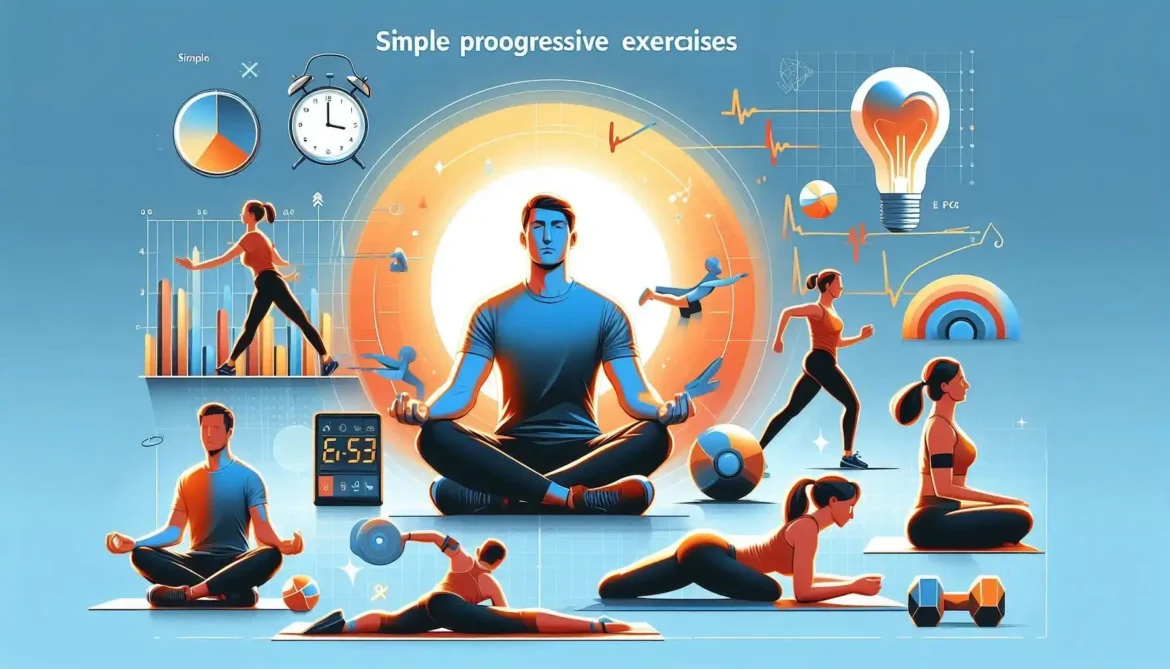
Progressive Bodyweight Exercises Enhance Heart Rate and Muscle Flexibility
In our journey towards better health and fitness, we often seek exercises that not only strengthen our muscles but also improve our cardiovascular health. Progressive body exercises are an excellent way to achieve these dual objectives. In this article, we will delve into the various progressive body exercises designed to enhance our heart rate and alleviate muscle strains.
Understanding Progressive Body Exercises
Progressive body exercises are a systematic approach to training that gradually increases the intensity of our workouts. The goal is to push our limits safely, allowing our bodies to adapt and grow stronger over time. This technique is beneficial for improving cardiovascular health and muscle strength, making it an ideal choice for anyone looking to enhance their fitness regime.
Key Benefits of Progressive Body Exercises
- Improved Cardiovascular Health: As we elevate our heart rate during workouts, our cardiovascular system becomes more efficient, improving blood circulation and overall heart health.
- Increased Muscle Strength: By gradually increasing resistance or intensity, we stimulate muscle growth and endurance, reducing the risk of injury and muscle strains.
- Enhanced Flexibility and Mobility: Many progressive exercises incorporate movements that improve our range of motion, making daily activities easier.
- Mental Toughness: Progressively challenging ourselves builds resilience, promoting a positive mindset towards fitness and health.
Types of Progressive Body Exercises
Let’s explore some effective progressive body exercises that can help us achieve a healthier heart and stronger muscles.
1. Bodyweight Exercises
Bodyweight exercises form the foundation of progressive training. These movements leverage our body weight to enhance strength and endurance.
- Push-Ups: Starting with knee push-ups and gradually moving to standard push-ups and then to decline push-ups can significantly enhance upper body strength.
- Squats: Begin with bodyweight squats, then advance to weighted squats, and finally, try single-leg squats for increased difficulty.
- Plank Variations: Start with a basic plank and progress to side planks and plank-to-push-up transitions for core stability and strength.
2. Cardiovascular Exercises
Cardiovascular exercises are essential for improving heart rate and endurance. Progressive variations can make these workouts more effective.
- Walking to Running: Start with brisk walking, gradually increasing pace, and then incorporate running intervals.
- Cycling: Begin with steady cycling, then introduce sprints or hill climbs to boost intensity.
- Jump Rope: A simple yet effective way to elevate heart rate; start with basic jumps and progress to double-unders or speed jumps.
3. Resistance Training
Incorporating resistance training is vital for muscle growth and strength improvement.
- Dumbbell Exercises: Start with light weights for exercises like bicep curls or shoulder presses, gradually increasing weight as strength improves.
- Resistance Bands: These are great for progressive overload; start with lighter bands and increase resistance as we build strength.
- Kettlebell Swings: Begin with lighter kettlebells and focus on form before moving to heavier weights.
4. Flexibility and Mobility Exercises
Flexibility and mobility are crucial to prevent muscle strains and enhance performance.
- Dynamic Stretching: Incorporate movements such as leg swings and arm circles before workouts to improve range of motion.
- Yoga: Gradually progress from basic poses to more advanced variations to enhance flexibility and balance.
- Foam Rolling: This technique helps in muscle recovery. We can start with lighter pressure and increase intensity as needed.
Progression Principles to Follow
When engaging in progressive body exercises, it’s essential to adhere to certain principles to avoid injury and maximize benefits.
- Incremental Increase: Gradually increase weight, duration, or intensity by about 10% each week to allow our bodies to adapt.
- Listen to Our Bodies: Pay attention to signs of fatigue or strain; rest and modify exercises as needed.
- Mix it Up: Incorporate different exercises to prevent boredom and work different muscle groups effectively.
A Practical Example of a Weekly Progressive Routine
| Day | Focus Area | Exercises |
| Monday | Full Body | Push-Ups, Bodyweight Squats, Planks |
| Tuesday | Cardio | Walking/Jogging Intervals |
| Wednesday | Upper Body | Dumbbell Rows, Overhead Press, Bicep Curls |
| Thursday | Flexibility | Dynamic Stretching and Yoga |
| Friday | Lower Body | Weighted Squats, Lunges, Deadlifts |
| Saturday | Active Recovery | Light Yoga or Foam Rolling |
| Sunday | Rest | Focus on hydration and nutrition |
Conclusion
In conclusion, progressive body exercises serve as a powerful means to improve heart rate and muscle strains. By gradually increasing the intensity and complexity of our workouts, we can achieve a healthier heart and a stronger physique. As we embark on this journey together, let us remember the words of fitness pioneer Jack LaLanne:
“Exercise is king. Nutrition is queen. Put them together, and you’ve got a kingdom.”
By embracing a comprehensive approach that includes progressive body exercises, we can create a sustainable fitness routine that promotes overall well-being. Let’s challenge ourselves and make progress toward a healthier lifestyle, one workout at a time!
- What are progressive body exercises?
Progressive body exercises are workouts designed to gradually increase physical intensity by adding weight, resistance, or repetitions. This approach helps build strength and endurance over time. - Who should engage in progressive body exercises?
These exercises are ideal for individuals seeking to enhance strength, endurance, or muscle mass, such as athletes and fitness enthusiasts. They are also beneficial for those recovering from injuries under professional guidance. - Who should avoid progressive body exercises?
People with severe injuries, chronic pain, or certain medical conditions should consult a healthcare professional before starting. It’s also advisable to avoid these exercises during acute illness or without proper form training. - What factors should be considered when performing these exercises?
Key factors include maintaining proper form to prevent injuries, setting realistic goals, ensuring adequate nutrition, and allowing sufficient rest. Age and current fitness level are also important considerations. - Are progressive exercises suitable for all ages and fitness levels?
Yes, but modifications are essential. Seniors or beginners might start with lighter resistance and gradually increase intensity. Consulting a professional is recommended to tailor the routine appropriately. - How should one start with progressive body exercises?
Begin with a baseline assessment of your current strength and endurance. Choose compound movements like squats or push-ups, and gradually increase intensity. Professional guidance can be helpful. - What role do nutrition and rest play in these workouts?
Adequate nutrition provides the necessary energy and supports muscle repair, while rest allows muscles to recover and grow. Both are crucial for effective progression and overall health. - What safety measures can prevent injuries during these exercises?
Warm up before starting, focus on proper form, and avoid overexertion. Use appropriate equipment and consider working with a trainer, especially when increasing intensity. - Can progressive exercises be done without equipment?
Absolutely. Bodyweight exercises like push-ups, squats, and lunges can be progressed by increasing reps, sets, or difficulty. Creativity and consistency are key. - How often should intensity be increased in progressive exercises?
Intensity should be increased when the current level feels manageable, typically every 1-4 weeks, depending on the exercise and individual progress. - What signs indicate readiness to progress?
If you can perform the current exercise with ease and maintain proper form, it’s time to increase intensity or load. - How can one track progress in these workouts?
Keep a workout log to monitor increases in reps, sets, or weight. Noticeable improvements in strength or endurance are also indicators of progress. - What types of exercises are best suited for progressive overload?
Compound exercises such as squats, deadlifts, bench presses, and pull-ups are effective because they engage multiple muscle groups and allow for easy progression. - Is professional guidance necessary for progressive exercises?
While possible to start alone, a professional can provide personalized plans and prevent injuries. They are especially helpful for those new to progressive training.
By following these guidelines, individuals can safely and effectively engage in progressive body exercises tailored to their needs and goals.
Medical Disclaimer: The information provided on this website is for general educational and informational purposes only and is not intended as a substitute for professional medical advice, diagnosis, or treatment. Always seek the advice of your physician or other qualified health provider with any questions you may have regarding a medical condition. Never disregard professional medical advice or delay in seeking it because of something you have read on this website.



